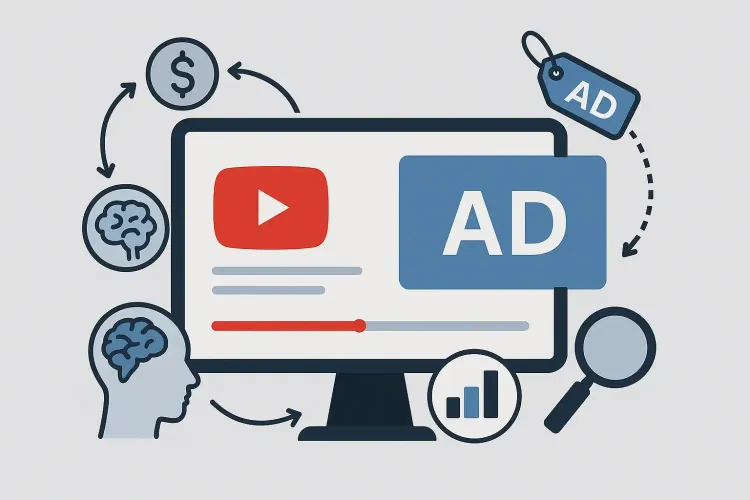YouTube Dynamic Ad Insertion (DAI): Complete Guide for Creators

YouTube generates over $30 billion a year in ad revenue, yet many creators still earn below their potential. One of the biggest shifts in monetization in recent years is Dynamic Ad Insertion (DAI), an AI-powered system that automatically determines when and where ads appear in your videos.
Instead of manually choosing ad breaks, YouTube’s algorithm identifies the best moments to insert ads based on viewer behavior and engagement. This change makes monetization smarter, faster, and more personalized, but it also reduces creator control.
Let’s break down how DAI works, its pros and cons, and how you can use it to maximize your earnings.
What Is YouTube Dynamic Ad Insertion?
Dynamic Ad Insertion (DAI) uses machine learning to insert ads in real time. It analyzes a video’s structure, pacing, and natural pauses, then combines that with viewer data and advertiser demand to determine optimal ad breaks.
DAI doesn’t just place ads randomly. It studies:
-
Viewer behavior and retention
-
Advertiser bids and categories
-
Brand-safety filters
-
Video length and engagement patterns
The system updates continuously, meaning each viewer may experience ad placements differently based on their watching habits and region.
Learn more in Google Ad Manager’s official documentation.
How It Works
When a creator uploads a video, YouTube’s AI scans it for potential breakpoints and context.
When a viewer hits play, the system instantly evaluates:
-
Their profile (location, watch history)
-
Advertiser demand at that moment
-
How many ads they’ve already seen
Then, a real-time auction takes place, advertisers bid for that impression, and the winning ad is inserted at the chosen point in milliseconds. The process repeats for every viewer, dynamically adjusting based on engagement and inventory.
Benefits for Creators
1. Higher Revenue:
DAI increases the number of eligible ad slots per video. Creators commonly see 20–40 % higher RPM, especially in long-form content and niches like finance or tech.
2. Passive Optimization:
No need to manually insert ads, DAI continuously adjusts for audience retention and advertiser demand.
3. Access to Premium Advertisers:
More ad inventory attracts higher-budget campaigns, boosting CPMs.
4. Detailed Metrics:
Creators can monitor ad performance, retention around ad breaks, and overall revenue uplift through YouTube Studio analytics.
To qualify, join the YouTube Partner Program (1 000 subscribers and 4 000 watch hours in the past 12 months).
Pros and Cons
Pros
-
Increased ad revenue
-
No manual setup required
-
Access to premium advertisers
Cons
-
Less control over ad placement
-
Possible viewer fatigue from more ads
-
Potential mismatch with content tone
For many creators, the passive revenue gain outweighs the loss of manual control, but it’s essential to balance monetization with audience experience.
Best Practices
-
Structure your videos with natural transitions or chapter breaks, DAI performs best when clear sections exist.
-
Prioritize long-form content (12 + minutes) for more insertion opportunities.
-
Track retention metrics, if viewers drop off at certain ad breaks, adjust your pacing.
-
Don’t overextend videos purely for ads, authenticity matters more.
-
Diversify revenue, combine DAI with memberships, sponsorships, or affiliate links.
The Future of DAI
YouTube’s DAI is still evolving. Expect:
-
More personalization: Ads tailored per viewer and moment.
-
Expanded control: Settings for max ad frequency or excluded categories.
-
Cross-format integration: Future inclusion across Shorts and Live content.
For creators, understanding how DAI interacts with engagement data will be key to sustainable growth.
FAQ
How do I enable DAI?
It’s automatically enabled for YouTube Partner Program creators with monetized videos.
Does it hurt watch time?
Not usually, as long as your content is engaging. But too many ads can cause drop-offs, so keep an eye on retention.
Is DAI available everywhere?
It’s strongest in major ad markets (U.S., U.K., Canada, Australia) and expanding globally.
Conclusion
Dynamic Ad Insertion is reshaping how YouTube monetization works, automating ad placement with AI to help creators earn more with less effort.
By understanding how DAI chooses ad moments, structuring your videos thoughtfully, and monitoring your analytics, you can strike the right balance between revenue and viewer satisfaction.
The future of YouTube monetization isn’t manual ad management, it’s mastering intelligent systems that work while you create.
Create your media kit with CreatorsJet
Stand out from the competition with a professional media kit created with CreatorsJet. Share all your social media analytics with the click of a button.
🚀 Create your media kit in minutes
✅ Automatically updated
💬 Share with the click of a button
free forever, no credit card required.
